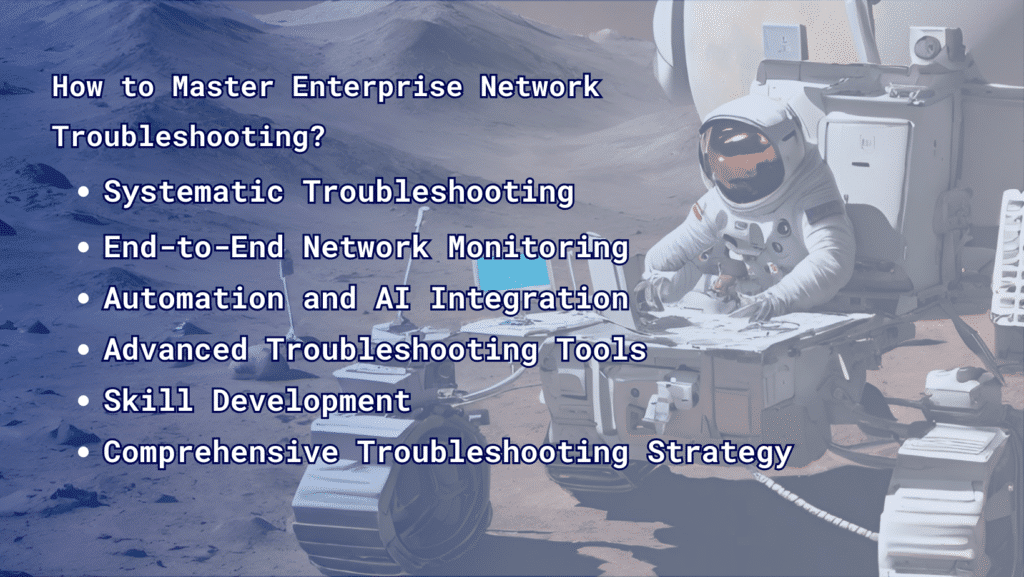How to Master Enterprise Network Troubleshooting: Ensuring Operations with AI Monitoring and Automation

In the realm of enterprise IT, network troubleshooting and diagnostics stand as twin pillars essential for the seamless execution of business operations. With the advent of cloud services and the proliferation of devices, today’s networks have evolved into intricate, multi-vendor environments characterized by their hybrid nature. This complexity not only enriches the IT landscape but also significantly amplifies the difficulty of diagnosing and resolving the myriad network issues that can arise. These challenges range from simple connectivity disruptions to complex, systemic problems that can jeopardize mission-critical operations. Network diagnostics play a critical role in this scenario, offering the initial insights needed to understand and subsequently troubleshoot these complexities effectively.
This article explores thoroughly the art and science of network troubleshooting and diagnostics. We begin by clarifying these concepts, explaining what they entail and why they’re cornerstones of robust IT infrastructure management. From there, we transition into practical territory, offering step-by-step guidance on diagnosing and rectifying common network connectivity issues. This includes strategies for identifying the root causes of disruptions, from hardware failures and software bugs to configuration errors and security breaches.
Recommended reading: How AI & Machine Learning are Changing Network Management
But we don’t stop at the basics. Recognizing that modern problems require modern solutions, we explore the pivotal role played by advanced Network Monitoring, Diagnostics, and Troubleshooting software. These tools are not just luxuries; they are necessities in the quest to maintain operational integrity and flawless continuity s. By harnessing the power of these technologies, IT professionals can gain unprecedented visibility into their networks, allowing for the early detection of issues before they escalate into a full-blown crisis.
Moreover, we emphasize the transformative impact of automation and artificial intelligence (AI) in the realms of network troubleshooting and diagnostics. The integration of predictive analytics and automated remediation capabilities into network management practices marks a paradigm shift in how enterprises approach the challenge of maintaining network reliability and performance. These advancements significantly reduce downtime and ensure that business processes run uninterrupted.
By taking into account all the above, this article will provide you with the knowledge and tools necessary to navigate the challenges of network troubleshooting and diagnostics confidently. Whether you’re struggling with sporadic connectivity issues or attempting to optimize your network for peak performance, the insights and strategies presented here will guide you towards achieving operational excellence.
The Intricacy of Enterprise Network Troubleshooting and Diagnostics
Mastering network troubleshooting and diagnostics requires a deep dive into the inherent complexities of modern enterprise networks. These networks are complex, filled with a myriad of technologies, devices, and protocols—all intricately woven together. This rich diversity, while beneficial to business operations, introduces a multitude of challenges that demand meticulous attention and expertise.
Complex Networks: The entanglement of legacy systems with cutting-edge technologies forms a labyrinthine web of interactions. Navigating this maze to pinpoint the source of an issue is similar to finding a needle in a haystack, requiring not just keen insight but also a broad understanding of both old and new networking paradigms.
Data Overload: In the digital age, network devices and applications are information floods of data, pouring out information in volumes that can quickly overwhelm. Cutting through this flood to extract actionable insights necessitates advanced analytical skills and the aid of sophisticated diagnostic tools.
Network Dynamics: As businesses evolve at a breakneck pace, their networks must adapt just as swiftly. Frequent updates and reconfigurations, while necessary for progress, can introduce unforeseen issues. Keeping abreast of these changes and their implications is crucial for maintaining network health and performance.
Network Visibility : Achieving comprehensive visibility is the cornerstone of effective network troubleshooting and diagnostics. However, the sheer complexity of enterprise networks often obscures the view, making it challenging to gain the end-to-end insight needed to identify and resolve issues efficiently.
Network troubleshooting, at its core, is a discipline devoted to identifying and rectifying the myriad issues that can arise within a computer network. These problems can manifest in various forms, from slow connection speeds and dropped connections to complete network outages. Employing a range of techniques—from analyzing network traffic and checking hardware and software configurations to testing network connections—network administrators can diagnose and resolve these issues, ensuring smooth and efficient network operation.
Moreover, Network Performance Troubleshooting elevates the game by focusing on issues specifically impacting the speed, reliability, and overall performance of the network. This specialized troubleshooting seeks to address problems leading to slow data transfer rates, dropped connections, application errors, and other operational disruptions, thereby ensuring the network’s optimal performance.

5 Common Network Troubleshooting Use Cases:
1. Slow Network Speeds: Identifying the root cause, whether it’s a congested network, a faulty switch, a misconfigured router, or an internet service provider missing its SLA, is vital for restoring optimal network performance as well as ensuring user’s quality of experience.
2. Dropped Connections: Pinpointing the source, be it interference from other devices, a faulty network card, or a weak signal, helps in re-establishing stable connections.
3. Network Outages: Swiftly diagnosing and addressing failures due to power outages, hardware failures, or configuration issues is crucial for minimizing downtime.
4. Security Breaches: Rapid identification and isolation of security breaches, such as malware infections, are key to safeguarding the network and preventing widespread damage.
5. Software Compatibility Issues: Resolving conflicts arising from new software installations ensures that network operations remain seamless and efficient.
Mastering Proactive Network Troubleshooting with AI-Driven Solutions
Ensuring network reliability before issues impact end-users is crucial in today’s fast-paced digital environment. Moving beyond reactive measures to a proactive network troubleshooting approach not only elevates network performance but also significantly enhances user satisfaction. This advanced strategy, which emphasizes anticipating and resolving network issues before they escalate, is at the heart of maintaining seamless operations.
Proactive network troubleshooting is characterized by the early identification and mitigation of potential network challenges. This forward-thinking approach leverages Continuous Network Monitoring, utilizing advanced network monitoring tools to track performance trends and pinpoint emerging issues. By conducting 24 by 7 monitoring, analyzing network metrics and adopting best practices, it’s possible to preemptively prevent many common network problems.
The significance of this approach lies in its ability to provide a comprehensive, real-time overview of the network’s state. This continuous alertness enables swift identification, localization, and resolution of issues before they adversely affect business critical networks as well as end-users. For service providers, in particular, this proactive stance is invaluable, helping to preserve their reputation by minimizing complaints and preventing service disruptions.
Embracing a proactive troubleshooting methodology not only reduces network downtime but also boosts network performance and security. The integration of AI-driven network monitoring and automation solutions plays a pivotal role in this process. These intelligent systems are designed to continuously analyze network data, identifying patterns that may indicate potential issues. Through predictive analytics and automated remediation, they can address problems before they become critical, ensuring that the network remains robust and reliable.
By adopting an AI-based approach to network troubleshooting, organizations can transform their network management practices. This not only streamlines operations but also positions them to better meet the demands of the digital age, ensuring that their networks—and their businesses—remain agile, resilient, and ready to embrace future challenges.
Systematic Troubleshooting: The Cornerstone of Network Health
Adopting a methodical approach to troubleshooting is foundational to the process. This involves a clear, step-by-step procedure for identifying, diagnosing, and resolving network issues, ensuring efforts are both efficient and effective.
Set Up End-to-End Network Monitoring
Establishing comprehensive network monitoring is the foundational step in a systematic troubleshooting approach, deploying tools for an end-to-end view of network performance across all networks and all network gear. These tools should offer real-time metrics, historical data analysis, visualizations, and alarms to provide insights into current and past network behavior, making it easier to spot and respond to issues promptly. Once in place, identifying network issues involves using a performance dashboard to analyze current conditions against historical data, utilizing visualizations and alerts to detect irregularities. This enables a detailed examination of network segments, ensuring swift identification and resolution of specific network issues.
Embracing Automation and AI
Incorporating automation and AI into the troubleshooting process can significantly enhance efficiency. Automation can handle routine tasks, reducing the potential for human error, while AI and machine learning provide predictive insights that help anticipate and mitigate potential issues before they impact the network. Efficient AI based network troubleshooting solutions can help save significant network expert time, allowing experts to focus on optimizing, planning and other important tasks rather than help with trouble tickets firefighting.
Recommended reading: Top 7 Benefits of Using AI for Network Monitoring and Operations
Advanced Troubleshooting Tools
Leveraging state-of-the-art network troubleshooting tools is key to minimizing the time and effort required to diagnose and resolve issues. These tools should offer in-depth insights into network performance and health, equipping administrators with the information needed to make informed decisions.
Skill Development
Continuous training and knowledge exchange are vital for keeping IT staff updated on the latest network technologies and troubleshooting techniques. Investing in skill development ensures the team is prepared to handle complex issues in an ever-evolving network environment.
Network Troubleshooting Steps: A Comprehensive Approach
By following a structured approach to network troubleshooting, IT teams can systematically address and resolve network issues, from slow speeds and intermittent connectivity to high latency and beyond. Each step, from setting up comprehensive monitoring to leveraging advanced tools and embracing AI, plays a critical role in maintaining optimal network performance. Through continuous improvement and skill development, organizations can ensure their networks remain robust, reliable, and ready to support business operations at every level.
Conclusion: The Future of Network Troubleshooting
As enterprises continue to navigate the complexities of modern IT environments, the importance of effective network troubleshooting cannot be overstated. Faced with the daunting challenges of intricate network structures and the need to sift through massive volumes of data, organizations are recognizing the necessity of a comprehensive approach to maintain network health and efficiency. By embracing a structured troubleshooting process, leveraging advanced tools and technologies, and prioritizing continuous skill development, organizations can significantly bolster their troubleshooting capabilities.
In this evolving landscape, the integration of AI-driven Network Monitoring and Automation solutions marks a pivotal shift towards more proactive and efficient network management. Solutions like those offered by NetOp have emerged as exemplary models, showcasing how comprehensive visibility, predictive analytics, and automation can transform the troubleshooting process. These innovations not only ensure the robustness and reliability of enterprise networks but also optimize performance to meet the dynamic demands of the digital age.
Beyond merely addressing immediate issues, the future of network troubleshooting lies in the continuous optimization of network performance and security. The journey from diagnosing problems to implementing solutions underscores the necessity of ongoing network monitoring.
As we look to the future, the significance of AI and automation in network troubleshooting will undoubtedly intensify, highlighting the critical need for enterprises to embrace these next-generation solutions. By doing so, they position themselves to navigate the complexities of their IT environments more effectively, ensuring their networks—and their businesses—remain agile, resilient, and primed for the challenges and opportunities of the digital frontier.
Embark on the journey to revolutionize your network troubleshooting process with AI-driven solutions that promise not just to resolve but to redefine how networks are managed. Contact us to explore how tools like NetOp’s Network Monitoring and Automation solution can elevate your network’s performance and operations, ensuring your enterprise is ready for the future of IT. Join businesses already experiencing the transformative power of advanced network troubleshooting solutions.

